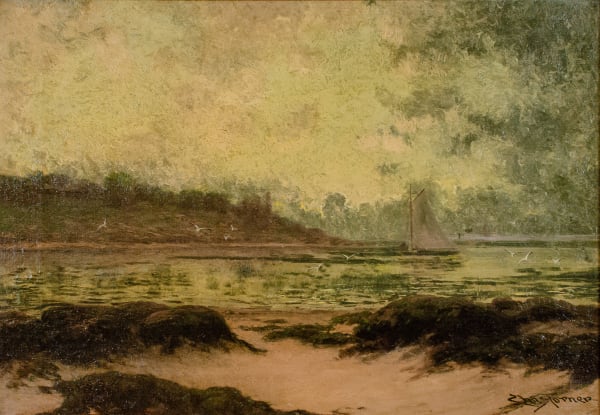Julian Onderdonk, landscape artist, son of Emily Wesley Rogers (Gould) Onderdonk and Robert Jenkins Onderdonk, was born Robert Julian Onderdonk in San Antonio on July 30, 1882. His parents were artists, and his father was also an instructor in art. From early childhood Julian showed definite artistic talent; he marveled at colors and reflections and drew sketches. His father, Robert, served as his first teacher. In the late 1890s young Onderdonk attended West Texas Military Academy, where he also taught art in order to pay his tuition. In 1900 Julian was an art teacher at Laurel Heights School.
In 1901 a loan from San Antonio banker G. Bedell Moore allowed Julian Onderdonk to go to New York to study. He attended the Art Students League, where he studied under Kenyon Cox and later Frank Vincent DuMond. In summer 1901 Onderdonk studied with American Impressionist William Merritt Chase (who had also taught Robert Onderdonk) at his Shinnecock Hills Summer School of Art in Southampton on Long Island. Chase encouraged his talents as a landscape painter and had a profound influence on Onderdonk. At some point, he also studied with Robert Henri. Julian Onderdonk married Gertrude Shipman, a native of New York, on June 18, 1902. They had two children-daughter Adrienne (born in New York in 1903) and son Robert (born in San Antonio in 1909).
In New York, Onderdonk was soon experiencing economic difficulties. Although his ability was recognized, his earnings were small. In 1904 he and his family moved to Staten Island, where he briefly taught on his own under the name of the Onderdonk School of Art. By this time, he also knew a business associate, Charles E. Tunison, who acted as a broker. Onderdonk supplied paintings to Tunison who sold them to department stores. This gave the artist a very modest but steady source of income to support his family. The years of 1904 to 1909 proved to be a particularly prolific period of output for Onderdonk, but he used pseudonyms such as Chas. Turner, Chase Turner, Elbert H. Turner, and Roberto Vasquez, to sign his works. Only decades later, did art historians discover the breadth of Onderdonk's New York paintings, and this ongoing study has served to broaden the artist's reputation beyond his Texas identity.
In 1906 Onderdonk took a salaried position organizing art exhibitions for the Dallas State Fair, a seasonal job he retained for a number of years. In November 1909 the Onderdonk family moved from New York to San Antonio. The 1910 census records that he and his wife, their daughter Adrienne, and their infant son Robert were living with extended family at his parents' home at 128 W. French Place in San Antonio. Here, in the expanse of Bexar County's hill country, Julian Onderdonk employed his en plein air ("in the open air") philosophy, that his mentor William Merritt Chase espoused, and did his best work as an interpreter of life and scenes in his native locale. About 1911 he took an interest in bluebonnets, which became his most popular and marketable landscapes. His many paintings include Sunlight and Shadow (1910), Spring Morning (1911), Bluebonnet Field (1912), Blue Bonnets in Texas (1915), Road to the Hills (1918), and Bluffs on the Guadalupe River (1921).
Following his father's death in 1917, Julian became his successor in promoting art in the city, and he actively spoke at luncheons, presented awards, and participated in other civic functions. Reproductions of his landscapes, including bluebonnets, were later sold to tourists at Joske's department store in San Antonio. At the peak of his success, when his paintings were bringing remunerative returns, Onderdonk died of an acute intestinal obstruction and appendicitis on October 27, 1922, in San Antonio. He was buried in Alamo Masonic Cemetery.
His last paintings, Dawn in the Hills and Autumn Tapestry, painted in 1922, were shown in the 1922 exhibition of the National Academy of Design in New York. Onderdonk was a member of the Salmagundi Club of New York, Allied Artists of America, and the San Antonio Art League. When the Witte Memorial Museum opened a few years later, his sister Eleanor served as its first curator, and the museum helped promote Onderdonk's wildflower landscapes. His works have been presented in numerous Texas art museums as well as other galleries across the nation. When President George W. Bush lived in the White House, among his choices of artwork were several works by Julian Onderdonk. In the early twenty-first century, the Texas Impressionist artist's landscapes were still in high demand among collectors and commanded up to several hundred thousand dollars.

